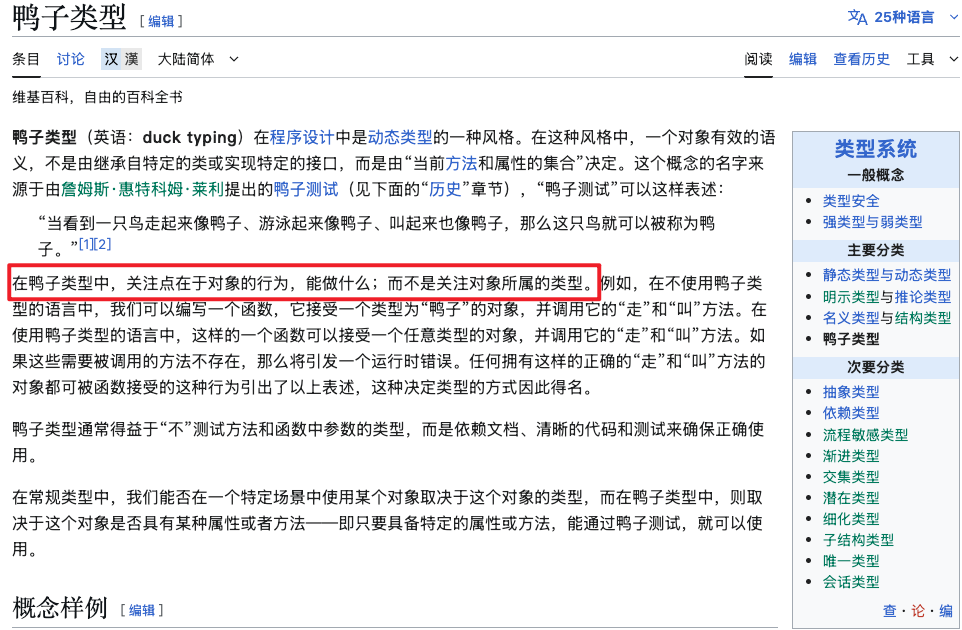字数 2587,阅读大约需 13 分钟
Go语言基础之接口 | 李文周的博客[1]
鸭子类型 - 维基百科,自由的百科全书[2]
深入了解Go的interface{}底层原理本文详细介绍了interface{}底层的两种数据类型iface 和 efa - 掘金[3]
深入研究 Go interface 底层实现[4]
“An interface type defines a type set. A variable of interface type can store a value of any type that is in the type set of the interface”
接口(Interface)是Go语言中最重要和最独特的特性之一。它不仅是Go实现多态性的核心机制,也是Go语言"组合优于继承"设计哲学的体现。本文将从六个方面深入探讨Go接口的核心概念和实际应用。
起源
鸭子类型:动态
结构化类型:静态
OCaml、Scala和Go语言采用结构化类型系统。

错误使用示例
func main() {
var x interface{} = nil
var y *int = nil
interfaceIsNil(x)
interfaceIsNil(y)
}
func interfaceIsNil(x interface{}) {
if x == nil {
fmt.Println("empty interface")
return
}
fmt.Println("non-empty interface")
}y 是一个「类型为 *int 的 nil 指针」,而不是「nil 接口」。当它被转换为接口类型时,接口会记录其实际类型(*int),因此不再被视为 nil 接口。
1. 什么是接口
在Go语言中,接口定义了一个类型集合。任何实现了接口中所有方法的类型都被认为实现了该接口。接口是一种契约,它规定了实现者必须提供哪些行为,而不关心具体的实现方式。在Go中,一种类型只要有合适的方法,就会自动实现接口
接口的定义语法
type InterfaceName interface {
MethodName1(parameters) returnType
MethodName2(parameters) returnType
}基本接口示例
// 文件操作接口
type File interface {
Read([]byte) (int, error)
Write([]byte) (int, error)
Close() error
}
// 字符串表示接口
type Stringer interface {
String() string
}接口的核心特点:
• 隐式实现:Go中不需要显式声明实现某个接口,只要类型拥有接口要求的所有方法,就自动实现了该接口
• 鸭子类型:如果它走起来像鸭子,叫起来像鸭子,那它就是鸭子
• 类型安全:在编译时检查接口实现的正确性
2. 接口的值接收者和指针接收者
在Go中,方法可以有值接收者或指针接收者,这直接影响接口的实现方式。
值接收者
type Circle struct {
Radius float64
}
// 值接收者方法
func (c Circle) Area() float64 {
return math.Pi * c.Radius * c.Radius
}
func (c Circle) String() string {
return fmt.Sprintf("Circle with radius %.2f", c.Radius)
}
type Shape interface {
Area() float64
}
func main() {
c := Circle{Radius: 5}
var s Shape = c // 值可以赋给接口
var s2 Shape = &c // 指针也可以赋给接口
fmt.Println(s.Area()) // 78.54
fmt.Println(s2.Area()) // 78.54
}指针接收者
type Rectangle struct {
Width, Height float64
}
// 指针接收者方法
func (r *Rectangle) Area() float64 {
return r.Width * r.Height
}
func (r *Rectangle) Scale(factor float64) {
r.Width *= factor
r.Height *= factor
}
func main() {
r := Rectangle{Width: 10, Height: 5}
// var s Shape = r // 编译错误!值不能赋给需要指针接收者的接口
var s Shape = &r // 只有指针可以赋给接口
fmt.Println(s.Area()) // 50
}混合接收者
type Counter struct {
count int
}
// 值接收者 - 不修改状态
func (c Counter) Value() int {
return c.count
}
// 指针接收者 - 修改状态
func (c *Counter) Increment() {
c.count++
}
type ReadableCounter interface {
Value() int
}
type WritableCounter interface {
Increment()
}
type Counter interface {
ReadableCounter
WritableCounter
}重要规则:
• 如果方法有值接收者,那么值和指针都能调用
• 如果方法有指针接收者,只有指针能调用
• 接口变量可以持有值或指针,取决于方法的接收者类型
3. 类型和接口的关系
一个类型可以实现多个接口
type Dog struct {
Name string
}
func (d Dog) Speak() string {
return "Woof!"
}
func (d Dog) String() string {
return fmt.Sprintf("Dog named %s", d.Name)
}
func (d Dog) Run() {
fmt.Printf("%s is running\n", d.Name)
}
// 多个接口
type Speaker interface {
Speak() string
}
type Runner interface {
Run()
}
type Stringer interface {
String() string
}
func main() {
dog := Dog{Name: "Buddy"}
var speaker Speaker = dog
var runner Runner = dog
var stringer Stringer = dog
fmt.Println(speaker.Speak()) // Woof!
runner.Run() // Buddy is running
fmt.Println(stringer.String()) // Dog named Buddy
}多个类型可以实现同一个接口
type Cat struct {
Name string
}
func (c Cat) Speak() string {
return "Meow!"
}
type Bird struct {
Name string
}
func (b Bird) Speak() string {
return "Tweet!"
}
// 多态性的体现
func MakeSound(s Speaker) {
fmt.Printf("Animal says: %s\n", s.Speak())
}
func main() {
animals := []Speaker{
Dog{Name: "Buddy"},
Cat{Name: "Whiskers"},
Bird{Name: "Robin"},
}
for _, animal := range animals {
MakeSound(animal)
}
}接口的类型断言
func IdentifyAnimal(s Speaker) {
switch v := s.(type) {
case Dog:
fmt.Printf("This is a dog named %s\n", v.Name)
case Cat:
fmt.Printf("This is a cat named %s\n", v.Name)
case *Bird:
fmt.Printf("This is a bird named %s\n", v.Name)
default:
fmt.Println("Unknown animal type")
}
}
// 安全的类型断言
func SafeTypeAssertion(s Speaker) {
if dog, ok := s.(Dog); ok {
fmt.Printf("Successfully converted to Dog: %s\n", dog.Name)
} else {
fmt.Println("Not a Dog")
}
}4. 接口组合和嵌套
Go语言通过接口嵌入实现接口的组合,这是一种强大的设计模式。
接口嵌入
type Reader interface {
Read(p []byte) (n int, err error)
}
type Writer interface {
Write(p []byte) (n int, err error)
}
type Closer interface {
Close() error
}
// 接口组合
type ReadWriter interface {
Reader
Writer
}
type ReadWriteCloser interface {
Reader
Writer
Closer
}
// 等价于
type ReadWriteCloser2 interface {
Read(p []byte) (n int, err error)
Write(p []byte) (n int, err error)
Close() error
}实际应用示例
type File struct {
name string
data []byte
pos int
}
func (f *File) Read(p []byte) (n int, err error) {
if f.pos >= len(f.data) {
return 0, io.EOF
}
n = copy(p, f.data[f.pos:])
f.pos += n
return n, nil
}
func (f *File) Write(p []byte) (n int, err error) {
f.data = append(f.data, p...)
return len(p), nil
}
func (f *File) Close() error {
f.data = nil
f.pos = 0
return nil
}
// File 自动实现了 ReadWriteCloser 接口
func ProcessFile(rwc ReadWriteCloser) {
data := []byte("Hello, World!")
rwc.Write(data)
buffer := make([]byte, len(data))
rwc.Read(buffer)
rwc.Close()
}复杂接口组合
type Validator interface {
Validate() error
}
type Serializer interface {
Marshal() ([]byte, error)
Unmarshal([]byte) error
}
type Processor interface {
Process() error
}
// 组合接口
type DataHandler interface {
Validator
Serializer
Processor
}
type User struct {
Name string `json:"name"`
Email string `json:"email"`
}
func (u *User) Validate() error {
if u.Name == "" || u.Email == "" {
return fmt.Errorf("name and email are required")
}
return nil
}
func (u *User) Marshal() ([]byte, error) {
return json.Marshal(u)
}
func (u *User) Unmarshal(data []byte) error {
return json.Unmarshal(data, u)
}
func (u *User) Process() error {
fmt.Printf("Processing user: %s\n", u.Name)
return nil
}5. 空接口
空接口 interface{} (或从Go 1.18开始的 any) 是Go中最特殊的接口。
空接口的特性
// Go 1.18之前
var empty interface{}
// Go 1.18及之后
var any_var any // any 是 interface{} 的别名
func main() {
// 空接口可以持有任何类型的值
empty = 42
fmt.Printf("Value: %v, Type: %T\n", empty, empty) // Value: 42, Type: int
empty = "hello"
fmt.Printf("Value: %v, Type: %T\n", empty, empty) // Value: hello, Type: string
empty = []int{1, 2, 3}
fmt.Printf("Value: %v, Type: %T\n", empty, empty) // Value: [1 2 3], Type: []int
}空接口的实际应用
// 泛型函数(Go 1.18之前的方式)
func PrintAny(value any) {
fmt.Printf("Value: %v, Type: %T\n", value, value)
}
// 处理不同类型的数据
func ProcessData(data any) error {
switch v := data.(type) {
case string:
fmt.Printf("Processing string: %s\n", v)
case int:
fmt.Printf("Processing int: %d\n", v)
case []any:
fmt.Printf("Processing slice with %d elements\n", len(v))
for i, item := range v {
fmt.Printf(" [%d]: %v\n", i, item)
}
default:
return fmt.Errorf("unsupported type: %T", v)
}
return nil
}
// JSON处理
func ParseJSON(jsonStr string) (any, error) {
var result any
err := json.Unmarshal([]byte(jsonStr), &result)
return result, err
}空接口的反射应用
import (
"reflect"
)
func AnalyzeValue(value any) {
rv := reflect.ValueOf(value)
rt := reflect.TypeOf(value)
fmt.Printf("Type: %s\n", rt.String())
fmt.Printf("Kind: %s\n", rv.Kind().String())
fmt.Printf("Value: %v\n", rv.Interface())
if rv.Kind() == reflect.Struct {
fmt.Println("Struct fields:")
for i := 0; i < rv.NumField(); i++ {
field := rt.Field(i)
value := rv.Field(i)
fmt.Printf(" %s: %v\n", field.Name, value.Interface())
}
}
}6. 接口值
接口值是Go中一个重要概念,理解它有助于更好地使用接口。
接口值的内部结构
接口值由两部分组成:
• 类型信息:存储具体类型的信息
• 数据指针:指向具体值的指针
func main() {
var w io.Writer
// nil接口值
fmt.Printf("w == nil: %t\n", w == nil) // true
// 赋值后的接口值
w = os.Stdout
fmt.Printf("w == nil: %t\n", w == nil) // false
// 类型信息和值都存在
fmt.Printf("Type: %T\n", w) // Type: *os.File
}接口值的比较
type Point struct {
X, Y int
}
func (p Point) String() string {
return fmt.Sprintf("(%d, %d)", p.X, p.Y)
}
func main() {
var s1, s2 fmt.Stringer
// 都是nil,相等
fmt.Println(s1 == s2) // true
// 相同类型,相同值
s1 = Point{1, 2}
s2 = Point{1, 2}
fmt.Println(s1 == s2) // true
// 相同类型,不同值
s2 = Point{3, 4}
fmt.Println(s1 == s2) // false
// 不同类型
s2 = fmt.Sprintf("hello")
fmt.Println(s1 == s2) // false
}nil接口值的陷阱
func main() {
var p *int
var i interface{} = p
// 这里要小心!
fmt.Printf("p == nil: %t\n", p == nil) // true
fmt.Printf("i == nil: %t\n", i == nil) // false!
// 正确的检查方式
if i == nil || reflect.ValueOf(i).IsNil() {
fmt.Println("Interface is effectively nil")
}
}
// 返回接口的函数中的常见错误
func GetWriter(useStdout bool) io.Writer {
if useStdout {
return os.Stdout
}
var f *os.File // 这是一个nil指针
return f // 但返回的接口不是nil!
}
// 正确的做法
func GetWriterCorrect(useStdout bool) io.Writer {
if useStdout {
return os.Stdout
}
return nil // 返回nil接口
}接口值的动态调用
type Calculator struct {
value float64
}
func (c *Calculator) Add(x float64) float64 {
c.value += x
return c.value
}
func (c *Calculator) Multiply(x float64) float64 {
c.value *= x
return c.value
}
type Computer interface {
Add(float64) float64
Multiply(float64) float64
}
func DynamicCall(c Computer) {
// 运行时动态调用
result1 := c.Add(10) // 动态分发到具体类型的Add方法
result2 := c.Multiply(2) // 动态分发到具体类型的Multiply方法
fmt.Printf("Results: %.2f, %.2f\n", result1, result2)
}总结
Go语言的接口设计体现了简洁而强大的特点:
1. 隐式实现让代码更加灵活,减少了耦合
2. 接收者类型影响接口的实现方式,需要根据具体需求选择
3. 多态性通过接口得到完美体现,一个接口可以有多种实现
4. 接口组合提供了强大的抽象能力,支持复杂的设计模式
5. 空接口提供了类型安全的动态类型系统
6. 接口值的理解有助于避免常见的nil接口陷阱
接口是Go语言设计哲学的核心体现,掌握接口的使用对于编写优雅、可维护的Go代码至关重要。通过合理使用接口,我们可以构建松耦合、高内聚的系统架构。
引用链接
[1] Go语言基础之接口 | 李文周的博客: https://www.liwenzhou.com/posts/Go/interface/[2] 鸭子类型 - 维基百科,自由的百科全书: https://zh.wikipedia.org/wiki/%E9%B8%AD%E5%AD%90%E7%B1%BB%E5%9E%8B[3] 深入了解Go的interface{}底层原理本文详细介绍了interface{}底层的两种数据类型iface 和 efa - 掘金: https://juejin.cn/post/7105423957565636639[4] 深入研究 Go interface 底层实现: https://halfrost.com/go_interface/




评论区